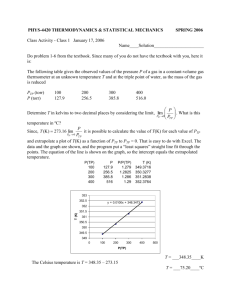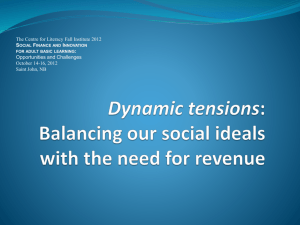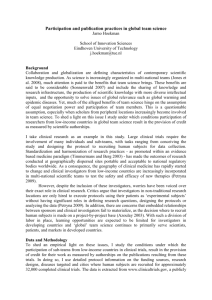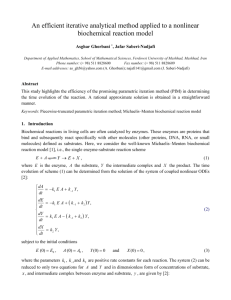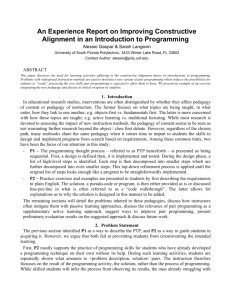RD50_PTP
advertisement
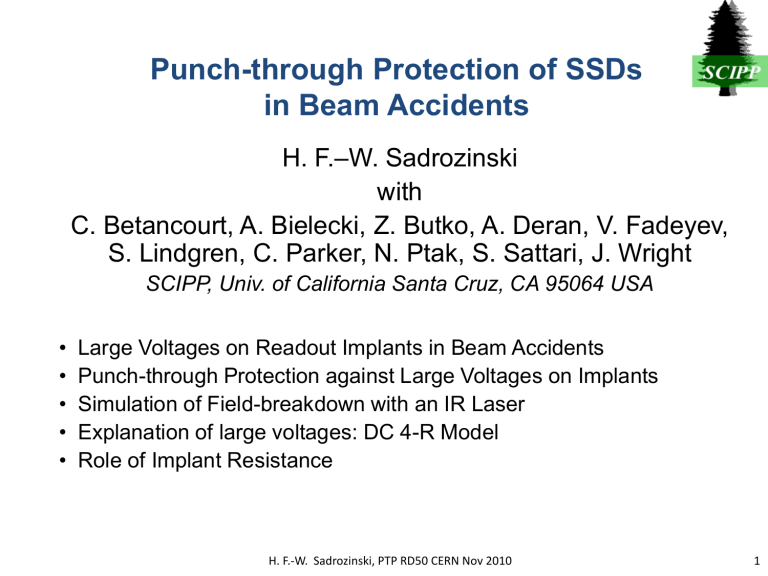
Punch-through Protection of SSDs in Beam Accidents H. F.–W. Sadrozinski with C. Betancourt, A. Bielecki, Z. Butko, A. Deran, V. Fadeyev, S. Lindgren, C. Parker, N. Ptak, S. Sattari, J. Wright SCIPP, Univ. of California Santa Cruz, CA 95064 USA • • • • • Large Voltages on Readout Implants in Beam Accidents Punch-through Protection against Large Voltages on Implants Simulation of Field-breakdown with an IR Laser Explanation of large voltages: DC 4-R Model Role of Implant Resistance H. F.-W. Sadrozinski, PTP RD50 CERN Nov 2010 1 Damage from Beam Losses to AC-coupled SSD • ALEPH at LEP observed break-down of the coupling capacitors on AC-coupled SSD in a beam accident. The Al readout trace of AC coupled sensors are held at ground by the readout ASIC. • We proposed that this was due to the breakdown of the field inside the sensor when the deposited charge made the sensor conductive. At that point, the bias voltage can reach into the sensor bulk and can impart large voltages to the implants. • To check this, we used IR lasers to mimic the beam loss and we indeed observed large voltages on the implants T. Dubbs et al., IEEE Trans. Nuclear Science 47, 2000:1902 – 1906. • The reach-through (punch-through) effect was considered an elegant and effective way to limit the voltages on the implants. Special punch-through protection (PTP) structure can be designed where the geometrical layout determines the voltage limits on the implants. J. Ellison et al., IEEE Trans. Nuclear Science, 36, 1989: 267 - 271. • PTP structures were implemented in the p-on-n SCT sensors. • But the PTP structure in SCT sensors were shown not to guarantee protection against large voltages across the coupling capacitors when IR laser pulses were used. K. Hara, et al., Nucl. Instr. and Meth. A 541 (2005) p. 15-20. H. F.-W. Sadrozinski, PTP RD50 CERN Nov 2010 2 PTP in Upgrade Sensors ATLAS07 N-on-P full-size sensors and “mini’s” to investigate PTP (in Zone 4A-4D) Y. Nobu, et al., NIMA A (2010)doi:10.1016/j.nima.2010.04.080 No PTP structure PTP structures BZ4A BZ4B BZ4C H. F.-W. Sadrozinski, PTP RD50 CERN Nov 2010 BZ4D 3 PTP Structure Effectiveness • • The effectiveness of PTP structures is determined in DC i-V measurements between the strip and the bias ring. One measures the “integral” effective resistance Reff, which is the bias resistor Rbias in parallel to the PTP resistor RPTP. The measure of the effectiveness of the PTP structure is the punchthrough voltage VPT , defined as the voltage at which RPTP = Rbias, i.e. Reff, = 0.5* Rbias . The PT voltage VPT was measured to be a few 10’s of Volt. 2.0E+06 W51 p-stop=4e12, Vbias=200V W51-BZ2-P8 W51-BZ3-P3 W51-BZ4A-P4 W51-BZ4B-P10 1.5E+06 Reff (Ohms) • 1.0E+06 5.0E+05 0.0E+00 -50 -40 -30 -20 Vtest (Volts) -10 0 S. Lindgren, et al., NIM A (2010) doi:10.1016/j.nima.2010.04.094 L [mm] VPT BZ4A 21 20 BZ4B 21 24 75 / 67 21 But: VPT shows very little variation with the dimension of the PTP structure (channel length L): BZ2 / BZ3 H. F.-W. Sadrozinski, PTP RD50 CERN Nov 2010 4 Testing Large Implant Voltages with Laser T. Dubbs et al., IEEE Trans. Nuclear Science 47, 2000:1902 – 1906. • Alessi IR cutting laser deposits large amounts of charge inside the detector which collapses the field(>1010 e/h pairs ~ 106 MIPs ~ 1 Rad / pulse). • Intensity given by number of laser triggers ~ 4 msec apart (we used up to 3). • Laser spot ~ 10 mm, but large DC voltages extend over few mm. • Peak voltage independent of laser intensity, and AC grnd/floating -180 W51-BZ4C Laser Profile Strip 10, 200Vbias -160 Voltage On Implant (V) • Bias ring is held to ground • Voltage on a DC pad and/or AC pad are read via an high impedance voltage divider into pico-probe or digital scope. • DC pad reflects biasing of strips, • AC pad reflects instantaneous collected charge ( ~ depleted region) 1 L Puls 3 L Pulses -140 -120 -100 -80 -60 -40 -20 0 -10 0 10 20 30 40 Distance Laser - Strip (# of Strips) Voltages on strips are large, much larger than DC VPT , comparable to bias voltage. H. F.-W. Sadrozinski, PTP RD50 CERN Nov 2010 5 Laser implant voltages near RPT vs. Bias 250 250 Laser near Vnear vs. Vbias, LP=505, LN, AC Ground W51-BZ4A-P4 200 200 W51-BZ4B-P10 Vnear [V] W51-BZ4C-P16 DC Voltage for RPT W51-BZ4D-P16 150 150 W51-BZ2-P8 W51-BZ3-P3 100 100 50 50 DC VPT 0 0 50 100 150 200 250 300 0 350 Vbias [ V ] At high bias voltages, implant voltages for PTP structures saturate. But the ones without PTP structures do not saturate (even though DC VPT were very similar) Can this be reconciled with the DC voltage dependence of RPT ? H. F.-W. Sadrozinski, PTP RD50 CERN Nov 2010 6 DC Characteristics of PTP Structures Extend the DC measurements to larger voltages and currents. Reff vs. Vnear Reff vs. PT current iPT 1.E+07 1.E+07 W51 p-stop=4e12, Vbias=200V W51 p-stop=4e12, Vbias=200V W51-BZ2-P8 W51-BZ3-P3 W51-BZ4A-P4 W51-BZ4B-P10 1.E+06 Reff (Ohms) Reff (Ohms) 1.E+06 1.E+05 1.E+05 W51-BZ2-P8 W51-BZ3-P3 W51-BZ4A-P4 W51-BZ4B-P10 1.E+04 -150 -130 -110 -90 -70 -50 -30 -10 Vtest (Volts) RPT never becomes a short Reff = 20 kW reached at different voltages for different structures. Strip Voltage depends on resistance of bulk and implant. 10 1.E+04 1.E-06 1.E-05 1.E-04 itest (A) 1.E-03 1.E-02 Reff ~ 1/ iPT Independent of structure! Reff = 10 kW reached at current of about 10 mA . H. F.-W. Sadrozinski, PTP RD50 CERN Nov 2010 7 Space-Charge Limitation in PTP Structures J.l. Chu, G. Persky, and S.M. Sze, J. Appl. Phys., Vol. 43, No.8, August 1972 J. Lohstroh et al. Solid-State Electronics. Vol. 24, No. 9, pp. 805-814, 1981 IPT vs. VPT iPTnear, LF (open) vs. VPT, LP=505, AC Ground 6.E-03 5.E-03 SCL I ~ V iPT near [ ] 4.E-03 3.E-03 2.E-03 W51-BZ4B-P10-N Punch-Through W51-BZ4C-P16-N W51-BZ4D-P16-N I ~exp(V) 1.E-03 W51-BZ2-P8-N W51-BZ3-P3-N W51-BZ4A-P4 0.E+00 0 20 40 60 80 100 120 140 160 180 200 Vnear [ V ] Punchthrough Region: IPT ~ exp(V), Rpt ~ 1/iPT, VPT saturates SCL Region: iPT~ V, Rpt ~ const1/iPT+const2, RPT saturates H. F.-W. Sadrozinski, PTP RD50 CERN Nov 2010 8 More evidence for SCL 1.E+06 RPTnear, LF (open) vs. iPT, LP=505, AC Ground RPT near [ ] RPT ~ 1 / iPT 1.E+05 for all PTP structures, W51-BZ4B-P10-N W51-BZ4C-P16-N W51-BZ4D-P16-N W51-BZ2-P8-N W51-BZ3-P3-N RPTnear, LF (open) and RPTfar, Ln (closed) vs. iPT, LP=505, AC Ground W51-BZ4A-P4 1.E-04 1.E+04 1.E-02 1.E-03 3.0E+05 W51-BZ4B-P10-F iPT near [ A ] W51-BZ4C-P16-F 2.5E+05 …but saturation of RPT at ~ 40kW for BZ2 and BZ3 SCL Region: RPT ~ const1 / iPT+ 40kW RPT near or RPT far [ ] W51-BZ4D-P16-F W51-BZ2-P8-N W51-BZ3-P3-N 2.0E+05 W51-BZ2-P8-F W51-BZ3-P3-F 1.5E+05 1.0E+05 5.0E+04 0.0E+00 0.E+00 H. F.-W. Sadrozinski, PTP RD50 CERN Nov 2010 1.E-03 2.E-03 3.E-03 iPT near or ifar [ A ] 4.E-03 5.E-03 9 Comparison between RPT(near) and RPT(far) RPTnear, LF (open) and RPTfar, Ln (closed) vs. VPT, LP=505, AC Ground 1.E+06 W51-BZ2-P8-N 1.E+06 W51-BZ3-P3-N RPT near or RPT far [ ] W51-BZ3-P3-F W51-BZ2-P8-F 1.E+05 1.E+04 0.00 1.E+05 50.00 100.00 150.00 200.00 1.E+04 250.00 Vnear or Vfar [ V ] Difference of “identical” near and far resistances in BZ2 and BZ3: Strong gate effect of the Poly bias resistor (c.f. FOXFET) Also: in BZ4A the Poly resistor has the best channel coverage H. F.-W. Sadrozinski, PTP RD50 CERN Nov 2010 10 Propose a DC “4R” Model • After breakdown of field inside the sensor, deal with DC resistor chain only RPTnear = Reff (RPTnear ,Rbias ) RPTfar = RPT on the far end of the strip, RPTfar > RPTnear Rimp = Resistance of implant 15kW/cm To check 4R Model: Rbulk = Bulk Resistance Fire laser both near and far. Measure both Vnear and Vfar Calculate Vnear = Vfar- Rimmp*Inear 250 Vnear vs. Vbias, LP=505, LN+LF, AC Ground W51-BZ4A-P4 W51-BZ4B-P10 W51-BZ4C-P16 W51-BZ4D-P16 W51-BZ2-P8 W51-BZ3-P3 W51-BZ4A-P4 W51-BZ4B-P10 W51-BZ4C-P16 W51-BZ4D-P16 W51-BZ2-P8 W51-BZ3-P3 Vnear (Volts) 200 150 Current regulates the punchthrough resistance through RPT ~ 1 / iPT 200 150 100 100 50 50 Voltages near RTP structures clamped independent of laser position 0 What about bulk resistance? 250 0 50 H. F.-W. Sadrozinski, PTP RD50 CERN Nov 2010 100 150 200 250 300 0 350 Vbias (Volts) 11 Bulk Resistance One more parameter after breakdown: Bulk resistance measured consistently Rb ≈ 15 kW (independent of the current) 5.E+04 5.E+04 W51-BZ2-P8-N Rbulk vs ibulk An approximately constant W51-BZ3-P3-N 4.E+04 4.E+04 W51-BZ4C-P16-N bulk resistance W51-BZ4D-P16-N W51-BZ4A-P4 Rb ≈ 15 kW depending on the inverse Rbulk [ ] and a PTP resistance W51-BZ4B-P10-N 3.E+04 3.E+04 2.E+04 2.E+04 1.E+04 1.E+04 of the current RPT ~ 1 / IPT can explain the saturation of the PTP voltages. 0.E+00 0.E+00 2.E-03 4.E-03 6.E-03 8.E-03 0.E+00 1.E-02 ibulk [ A ] H. F.-W. Sadrozinski, PTP RD50 CERN Nov 2010 12 Effect of Finite Implant Resistance Rimp Fire laser at the far end of the 1 cm strip, measure both Vnear and Vfar Laser far 250 250 250 Vfar vs. Vbias, LP=505, LF, AC Ground Vnear vs. Vbias, LP=505, LF, AC Ground 200 200 200 W51-BZ4B-P10 W51-BZ4C-P16 W51-BZ4D-P16 150 150 W51-BZ2-P8 W51-BZ3-P3 W51-BZ4A-P4 100 50 50 0 0 50 100 150 200 250 300 0 350 Vfar > Vnear Saturation in Vnear No saturation in Vfar RTP structure not effective for Vfar Vfar (Volts) Vnear (Volts) W51-BZ4D-P16 100 200 W51-BZ4B-P10 W51-BZ4C-P16 150 250 150 W51-BZ2-P8 W51-BZ3-P3 W51-BZ4A-P4 100 100 50 50 0 0 50 100 Vbias (Volts) 150 200 Vbias (Volts) 250 300 0 350 Limitation of application of PTP structures: finite Rimp Implant Voltages do not saturate at high bias voltages, if finite implant resistance Rimp isolates PTP structure from breakdown region. H. F.-W. Sadrozinski, PTP RD50 CERN Nov 2010 13 Conclusions • An IR cutting laser simulates the beam accident conditions: large Q, collapsing E-field. • Field breakdown size ~ 0.5 mm, with a much larger area with partial breakdown . • Voltages on the implants V > VPTP (DC), due to finite RPTP. • The observed voltages can be explained by 4 resistor DC model : RPTP(near), RPTP(far), Rbulk , Rimplant. • For PTP structures, the voltage near the laser VPTP(laser, near) saturates. Then RPTP ~20kW; I ~ 5 -10 mA. • Saturation voltage V = 50 – 100V • RPTP ~ 1 / iPT, while Rbulk ~15kW. For no PTP structure, RPTP saturates at ~ 40kW (SCL region) • Rimplant is very important: the present value, ~15 kW/cm, can effectively isolate the collapsed field from the PTP structure, increasing voltages on the implants by 100’s of volts => need low Rimplant! • The effect of the R-C biasing network at the backplane will be studied next. 2010/11/02 H. F.-W. Sadrozinski, PTP RD50 CERN Nov 2010 14 Acknowledgements The early work on the PTP measurements on ATLS07 sensors from HPK was shared within the ATLAS Upgrade Collaboration with: Y. Unno, S. Terada, Y. Ikegami, T. Kohriki, S. Mitsui Inst. of Particle and Nuclear Study, KEK, Oho 1-1, Tsukuba, Ibaraki 305-0801, Japan K. Hara, N. Hamasaki, Y. Takahashi, Univ. of Tsukuba, Inst. of Pure and Applied Sciences, Tsukuba, Ibaraki 305-9751, Japan A. Chilingarov, H. Fox Physics Department, Lancaster University, Lancaster LA1 4YB, United Kingdom H. F.-W. Sadrozinski, PTP RD50 CERN Nov 2010 15
